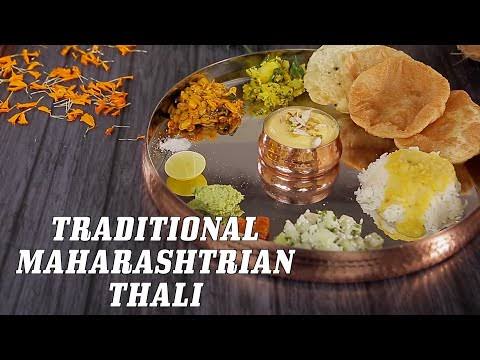Gudi Padwa 2020: 7 Recipes For A Complete Traditional Gudi Padwa Thali
Gudi Padwa is an auspicious occasion and is incomplete without traditional delicacies. Here are 7 traditional recipes that you can make to complete your Gudi Padwa thali!
Puran Poli Recipe : Nothing’s better than this delicious treat on Gudi Padwa. Simply making this one dish makes the day!
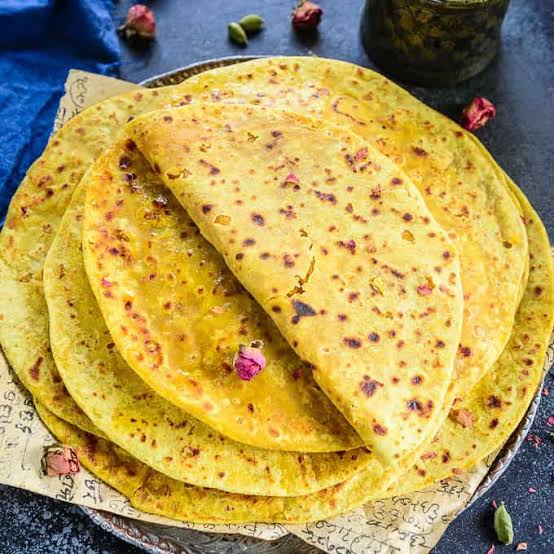
For the puran mixture – Sweet filling
- 1 cup powdered jaggery / gur
- 1 cup chana dal / skinned spilt bengal gram
- 3 cups water for pressure cooking the chana dal
- 2 tsp ghee
- 1 tsp fennel powder / saunf
- Tsp ¾ to 1dry ginger powder / saunth
- Tsp ½cardamom powder or 4-5 cardamoms crushed finely
- Tsp ¼nutmeg powder / jaiphal powder
For the Poli – Outer covering
- 1.5 cups whole wheat flour / atta + ½all purpose flour / maida or you can also use 2 cups whole wheat flour instead
- 1 tsp oil or ghee tsp ½salt or as required
- Tsp ¼turmeric powder / haldi (optional to give a faint yellow color to the poli)
- Water as required to knead the dough oil or ghee as required for frying the puran poli
The Puran
- Wash the chana dal in water.
- Now add the pressure cooker, add the chana dal and cook it for 6 to 7 whistles.
- Drain out the excess water.
- Now, in a pan add some ghee. Once the ghee is hot add dry ginger powder, nutmeg powder, cardamom powder and fennel powder. Saute.
- Now, add the jaggary and chana dal. Stir well.
- Now let the mixture cook on low flame till the mixture had no water and is dry.
- Keep stirring the mixture.
- Once the mixture is dry and thick, turn off the gas.
- Once cooled, mash with a potato masher. Or blend in a mixer.
Poli Dough
- Separately, in a bowl add whole wheat flour/atta, flour/maida and salt. Mix well.
- Add water and ghee and mix. Knead the dough.
- Knead till the dough be smooth and soft. Keep the dough aside for 15-20 minutes.
Puran Poli
- Take a medium or large size ball from the dough. roll it 2-3 inches in circumference on a dusted rolling board.
- place a portion of puran mixture in the center of the rolled dough.
- bring the edges together towards the center. join all the edges and pinch them.
- sprinkle some flour and start rolling the dough.
- make a medium or large circle (poli) as depending upon the size of the dough and puran filling you took.
- Heat a tawa, and spread some ghee. Place the rolled poli on the tawa.
- Once one side gets browned, turn the poli over. And cook the other side.
- Make all.
Shrikhand Recipe: Sweetly delicious! A traditional Indian sweet dish that is curd-based with a touch of elaichi
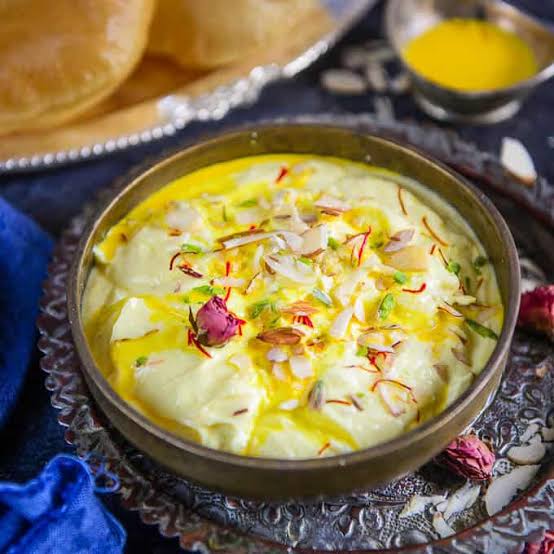
Serve delicious shrikhand with the meal to get that sweet and tangy delicacy that’s perfect for summers.
For hung curd :
- 4.5 kg cups fresh full fat dahi (About 1.125or 1.125 liters, curd made from 1 liter milk)
For Shrikhand:
- 8 to 9 tsp sugar or powdered sugar add as per taste
- tsp ½cardamom powder or 4 to 5 green cardamoms crushed finely in a mortar-pestle
- 2 pinch saffron strands
- Tbsp ½warm milk
- 7 to 8 crushed or chopped pistachios for garnish, you can use any dry fruit of your choice
Step by step instructions to make hung curd or yogurt
- To start with line the strainer on a profound dish. at that point line a muslin cheesecloth or kitchen cotton towel on the strainer.
- Pour the crisp curd. i included some curd (produced using 1 liter of full fat milk, around 1.125 kgs). do use crisp curd and not acrid one.
- Bring the four edges of the muslin together and tie one edge firmly around the rest.
- Tenderly press and you will see the whey dribbling.
- Presently put an overwhelming bowl or cover or plate on the tied muslin. on the off chance that you have a snare, you can likewise hung the muslin in your icebox. presently keep the entire thing in the ice chest for 4 to 5 hours or overnight. i kept for 24 hours. do utilize a profound bowl underneath, with the goal that there is some separation between the curd in the strainer and the gathered whey. generally the whey will touch the strainer and in addition the curd. subsequently there will be some whey in the curd.
- Following day the whey will be depleted and the hung curd will be prepared. utilize the gathered supplement rich greenish whey in your regular sustenance like planning chapatis, sauces, rice dishes, dals and so forth.
- With a silicon spatula, gather the hung curd in a holder or lidded dish if not utilizing it. spread with its cover and afterward refrigerate. with the hung curd you can now continue to make the shrikhand.
Step by Step instructions to make shrikhand
- Take ½ tbsp warm drain in a little bowl. include 2 squeeze of saffron strands. blend and keep aside.
- In a mortar powder 4 to 5 green cardamoms. keep aside.
- Take the chakka or hung curd in a dish.
- Include fine sugar. gently blend with a spatula or spoon. you can likewise utilize powdered sugar.
- At that point include the saffron disintegrated drain and powdered saffron.
- Utilizing an electric whipper, start to whip the hung curd. you can likewise beat the hung yogurt in a blender.
- Whip till smooth. the sugar ought to additionally break up. check the taste and include more sugar if needed.
- With a silicon spatula rub the whippers’ sides and edges of the hung curd and add to the dish.
- You can cool the shrikhand in ice chest and later serve. while serving top with some cut dry organic products. you can likewise best shrikhand with pounded dry natural products. i included some squashed pistachios for enhancement
Poori Bhaji Recipe: Nothing tastes better with puri than good old fashioned potato masala. An ideal side dish, it can be easily made with potatoes, green chillies and onions. The addition of cumin seeds lend a distinct flavour to this dish. So, cook up a storm with this delicious potato masala!
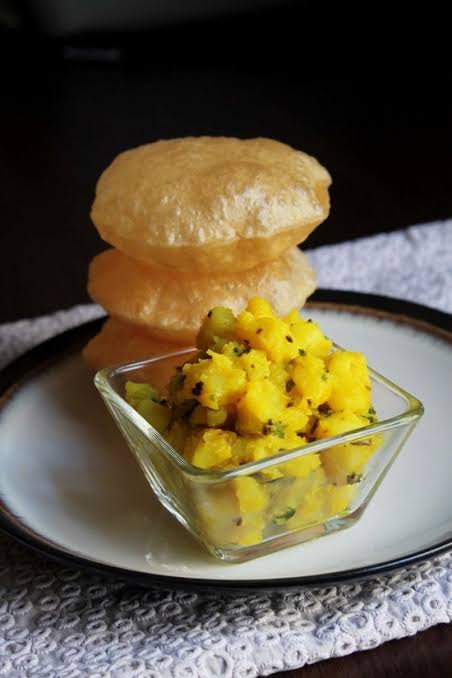
Complete your thaal with delicious poori and aloo bhaji!
For bhaji:
- 4 medium potatoes
- 1 large onion chopped
- 1 green chili chopped
- 1 tsp mustard rai or sarson
- 1 tsp cumin jeera
- 1.5 tsp urad dal / black gram
- ¾ cup Water
- ½ tsp Turmeric powder haldi a pinch of asafoetida hing
- ½-¾ cup coriander chopped
- 1 inch ginger / adrak finely chopped
- 12-15 leaves Curry (kadi patta)
- 2-3 tbsp peanut oil or sunflower oil Salt as required.
For Poori
- 3 cups whole wheat flour or atta
- 1 tsp melted ghee or oil optional
- Salt as required
- Water as required
- Oil for deep frying
Step by Step method:
For bhaji :
- Boil the potatoes till they are cooked completely.
- Once they are warm, peel them and chop.
- In a pan, heat oil. add cumin, mustard and urad dal.
- Fry till the mustard crackles and starts making sound and the urad dal begins to turn brown.
- Add the chopped onion. fry till they become soft & transparent.
- Now add the ginger and green chilies. fry for a minute.
- Add the curry leaves. stir and fry for some seconds.
- Add the turmeric and asafoetida. stir and fry for some seconds. don’t burn the turmeric.
- Next, add the chopped potatoes, half of the coriander leaves.
- Stir. now add ¾ water and salt. stir and cover the pan.
- Let the bhaji simmer for 5-6 minutes on a low flame.
- There should be some moisture in the bhaji and it should not be very dry.
- Add the remaining coriander leaves.
- Stir and serve batata bhaji hot with pooris
For Poori
- Seive the whole wheat flour with salt. add melted ghee or oil.
- Add little water at a time and knead well to form a dough. the dough should not be soft but a little stiff and tight.
- Divide the dough into small or medium pieces – about 12-14.
- Make into medium sized or slightly small balls and roll out into small circles.
- Heat oil in a deep frying pan or kadai.
- When the oil is sufficiently hot then add one poori at a time and fry gently pressing down with the frying spoon or slotted spoon in a circular motion.
- Turn over when puffed up and fry the poori till golden brown.
- Serve hot
Modak Recipe: Make your Gudi Padwa sweeter with this delicious Coconut Jaggery Modak! This traditional Indian sweet is made using only Rice flour, Jaggery, Coconut, Ghee and Cardamom. Super easy to make, this recipe is guaranteed to add a little sweetness to your life!
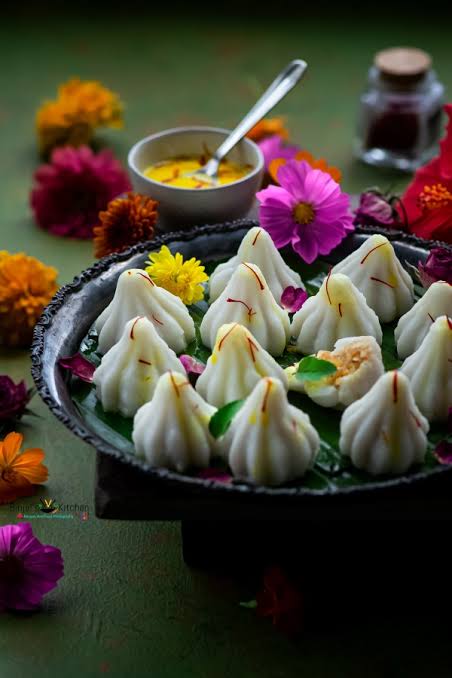
A traditional treat that’s perfect for all auspicious occasions.
For the stuffing
- 1 bowl Grated coconut
- ½ bowl jaggery
- ½ bowl sugar
- 1 cup assorted dry fruits (cashews almonds, pistachios and raisins)
- 2-3 tbsp ghee
- Pinch of cardamom
- 2 mawa (optional)
- 1 poppy seeds
For the outer cover
- 2 bowls rice flour
- 2 tbsp ghee
- Pinch of salt
- Hot water
Step by Step method:
For the stuffing:
- Heat a thick bottomed pan and add ghee to it. Add the poppy seeds and sauté or a minute or two.
- Add the grated coconut, cardamom powder, sugar and the assorted dry fruits and mix well.
- Cook over low flame until all the moisture is evaporated.
- Stir continuously keeping an eye on the colour as jaggery tends to harden when over cooked.
- Switch off the flame and set aside.
For the outer cover
- Add salt and glee to the flour and mix thoroughly.
- Boil water and add little ghee to it.
- Add the dough to the water, lower the heat and mix thoroughly.
- Knead the dough into a smooth paste. Cover the vessel until the rice cooks.
- Cook until the mixture reaches rolling consistency.
- Once done, set aside to cool.
Making of the modaks
- Smear ghee onto your palms and make some balls out of the dough.
- Roll it out into tiny discs and shape them into a cone. Press the edges of the cone to make it look like the petals of a flower.
- Fill the cone with the mixture and seal it by pressing the open ends together.
- Make sure the mixture doesn’t come out.
- Repeat for the rest of the modaks too.
- Steam the modaks over a banana leaf or muslin cloth for 5-6 minutes.
- Serve the modaks hot!
Usal Recipe: Usal is a quintessential part of a Maharashtrian thali so don’t leave out this healthy treat.
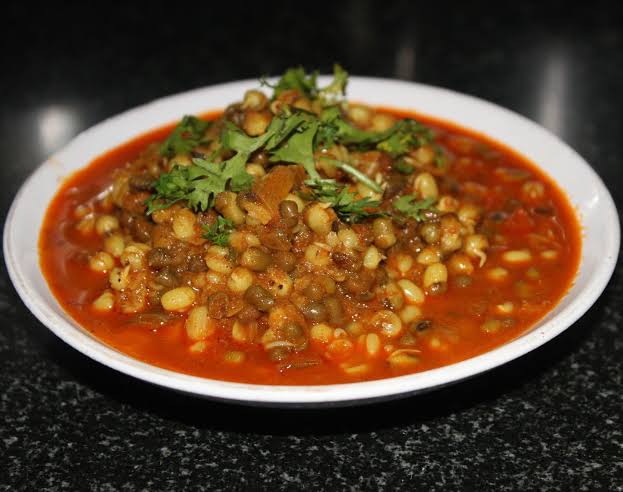
INGREDIENTS:
For cooking sprouts
- 1.5 cups mixed legumes sprouts (legumes)
- 1.25 cups water for cooking sprouts.
For the usal masala
- 1 tablespoon oil
- 1 tablespoon coriander seeds
- ½ tablespoon fennel seeds (saunf)
- ¼ cup onion, chopped
- 4 to 5 medium garlic cloves (lahsun), chopped
- ½ inch ginger (adrak), chopped
- ½ cup desiccated coconut or ½ cup fresh coconut
- ½ to ⅔ cup water for grinding the masala paste.
For the Usal
- 2 tablespoons oil
- ¼ cup onion or 1 medium sized onion, chopped
- ⅓ cup chopped tomatoes or 1 medium sized tomato, chopped
- ½ teaspoon red chili powder (lal mirch powder)
- ½ teaspoon turmeric powder (haldi)
- 1 teaspoon malvani masala or goda masala or ½ teaspoon garam masala (optional)
- 1 cup of broth or stock got from boiling the sprouts or water
- salt as required
- 2 to 3 tablespoons coriander leaves for garnishing
INSTRUCTIONS:
Cooking mixed bean sprouts
- Sprout ½ cup of dried mixed beans a couple of days before to make the usal. You will need 1.5 cups of mixed bean sprouts.
- Pressure cook or steam the sprouted beans till they are cooked. If pressure cooking, then cook the mixed bean sprouts in 1.25 cups water.
- When the bean sprouts are cooked and tender. Keep the cooked mixed sprouts aside.
Making Usal masala
- On a tava or pan heat 1 tablespoon oil. Add the chopped onion.
- Fry the onions till they become translucent.
- Add the fennel seeds and coriander seeds to the onions. Fry till they become aromatic.
- Add chopped ginger and garlic and fry these too for 1 to 2 minutes.
- Add the desiccated coconut.
- Stir and mix it well with the rest of the mixture.
- Fry the coconut till golden brown. But remember not to burn the coconut and to fry the masala on a low flame.
- Let the masala mixture cool. Then make a smooth paste of the masala ingredients in the grinder with ½ to ⅔ cup water.
Making Usal
- In another pan, heat 2 tablespoon oil. Add the chopped onions.
- Saute the onions till they turn translucent.
- Next add the chopped tomatoes.
- Saute the tomatoes for 2 to 3 mins or till they soften.
- Pour the ground masala paste. Since we have already browned the paste, we have less work to do. Just fry the paste for 1 to 2 minutes.
- Add the turmeric powder, malvani masala and red chili powder.
- Mix the above powders well with the coconut paste.
- Add the boiled sprouts to the paste.
- Add 1 cup broth or stock or add more, as per the consistency desired by you. You can also add water instead of broth or stock.
- Add salt. Lastly let the entire curry simmer for 12 to 15 minutes or till you see some oil floating on top.
- Last step is to add chopped coriander leaves.
- Serve maharashtrian usal with steamed rice or bhakri or pav or phulkas or pooris. You can also make misal pav with this malvani usal recipe.
Thalipeeth Recipe: Thalipeeth is absolutely delicious and we love it simple with a bowl of curd or even a fiery pickle.
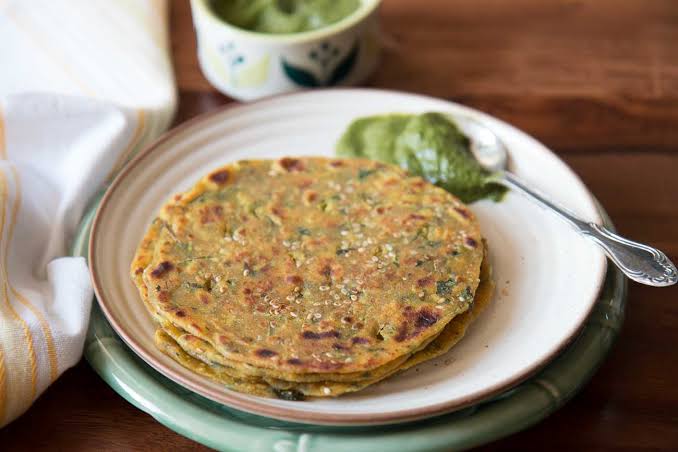
INGREDIENTS
For making thalipeeth dough
- ½ cup jowar (sorghum flour)
- ¼ cup atta (whole wheat flour)
- ½ cup bajra (pearl millet flour)
- ¼ cup besan (gram flour)
- ¼ cup rice flour (chawal ka atta)
- ¼ teaspoon ajwain (carom seeds)
- ¼ teaspoon turmeric powder (haldi)
- ¼ teaspoon red chilli powder
- ½ teaspoon cumin powder (jeera powder)
- 1 teaspoon coriander powder (dhania powder)
- 1 tablespoon sesame seeds
- 1 medium onion or ½ cup finely chopped onions
- 1 teaspoon finely chopped ginger
- ¼ cup chopped coriander leaves
- 1 green chilli – finely chopped
- 1 teaspoon oil
- salt as required
- ¾ cup + 2 to 3 tablespoons water or add as required
Other ingredients
- Oil as required for roasting
INSTRUCTIONS
Making Thalipeeth dough
- First take all the flours, spice powders, carom seeds, sesame seeds, onions, ginger, green chili, coriander leaves and salt in a mixing bowl or pan.
- Add 1 teaspoon oil.
- Mix everything very well.
- Then add water in parts and as required.
- Begin to mix the dough.
- Continue to add water in parts and mix everything to a soft and smooth dough. Dough has to manageable, moist and very smooth. Depending on the quality and texture of the flour, you can add less or more water.
Making Thalipeeth
- Then wet a muslin cloth or a cotton kitchen napkin with water. Wrung the extra water and spread the muslin on the rolling board. The muslin should be moist. Also heat the tawa.
- Now take a portion of the dough. Roll in your palms and flatten it on the muslin.
- With your fingers gently press and flatten the dough to get a flatbread with ¼ inch thickness. While flattening you can sprinkle a few drops of water also on the dough.
- Make hole in the center or make 3 to 4 holes at the sides. This helps in frying the thalipeeth well.
- Spread a bit of oil on the tawa. The tawa has to hot. So you can keep it on medium to high flame. Regulate the flame as required.
- Lift the muslin cloth and gently place it with the thalipeeth side touching the tawa.
- Now carefully peel the muslin from the rolled thalipeeth dough.
- Sprinkle some oil in the holes as well as the edges.
- Cover with a lid and let the thalipeeth cook for 2 to 3 minutes or till you the base is golden and crisp. You can brown the base more if you want.
- Turn over and continue to cook the second side also till you see some brown or charred spots on them.
- Remove and serve thalipeeth hot.
- If not serving hot, then you can stack the thalipeeth in a roti basket or casserole, so that they stay warm. Prepare all the thalipeeths this way.
- Serve thalipeeth recipe with white butter or fresh curd or pickle or thecha.
Kothimbir Vadi Recipe: A savoury snack that’ll elevate your thali!
HOW TO MAKE KOTHIMBIR VADI: Step by Step method:
1. Heat a tawa or pan and keep the flame to a low or medium. Add ¼ cup peanuts.

2. Stir at intervals and roast till the peanuts become crunchy. The peanuts skin will also have some brown-black spots on them. Remove them on a plate and let them cool.

3. Rub the peanuts in your palms. This will remove the flaky skin. Now add the peanuts in a small grinder jar.

4. Grind to a coarse powder. Remove and keep aside.

5. In the same small grinder, add 1 teaspoon ginger, 1 teaspoon garlic and 2 green chilies (or 2 teaspoons green chilies).

6. Add 1 to 2 tablespoon water and grind to a smooth paste. Keep aside. Alternatively, you can even crush the garlic, ginger and green chilies in a mortar-pestle.

MAKING KOTHIMBIR VADI BATTER:
7. Rinse coriander leaves very well. Drain the extra water and finely chop them. You will need 2 cups of finely chopped coriander leaves. Take the coriander leaves in a mixing bowl.

8. Add the ginger+garlic+green chilli paste.

9. Now add ¼ teaspoon turmeric powder, ¼ teaspoon red chili powder, ½ teaspoon coriander powder, ½ teaspoon cumin powder and 1 pinch of hing (optional).

10. Next add the coarsely ground peanut powder and 1 tablespoon white sesame seeds.

11. Add 1 cup besan (gram flour).

12. Now add ½ teaspoon sugar (optional) and salt as required.

13. Mix everything very well.

14. Now add ½ cup water in parts and begin to mix the batter.

15. Mix well to a thick batter. Add water as required and in parts.

STEAMING KOTHIMBIR VADI
16. Grease a pan with some oil.

17. Now add the batter in the pan.

18. Bring to boil 1 to 1.5 cups water in another pan.

19. Lower the flame and using tongs gently keep the pan with the batter inside the pan with water.

20. Cover with a lid and steam on a low to medium flame.

21. Once done, check with a tooth pick and it should come out clean. When the kothimbir mixture is cooled, then gently remove the entire layer on a plate. With a butter knife loosen the edges and invert the pan on a plate. Tap the pan and unmold the layer.

22. Now cut in square or diamond shaped slices.

FRYING KOTHIMBIR VADI
23. Heat 3 tablespoons oil in a tawa or pan. Place the steamed kothimbir vadi and pan fry on medium flame.

24. When the base is golden, flip and fry the other side.

25. Flip a couple of times more and fry till the sides are crisp and golden. You can even deep fry them if you want.

26. Place the pan fried kothimbir vadi on kitchen paper towels for extra oil to be absorbed.

27. Fry the remaining kothmir vadi in the same way.

28. Serve kothimbir vadi hot or warm with any chutney or sauce of your choice. You can serve them with saunth chutney or coconut chutney or mint chutney or coriander chutney.

